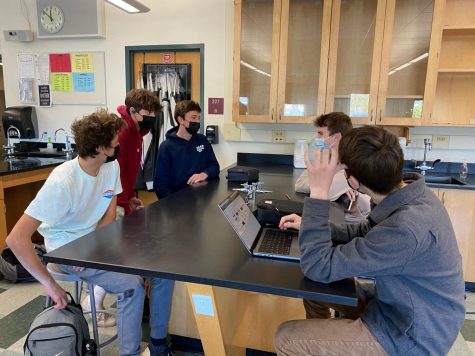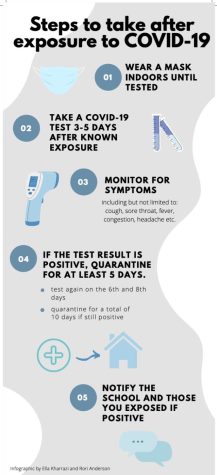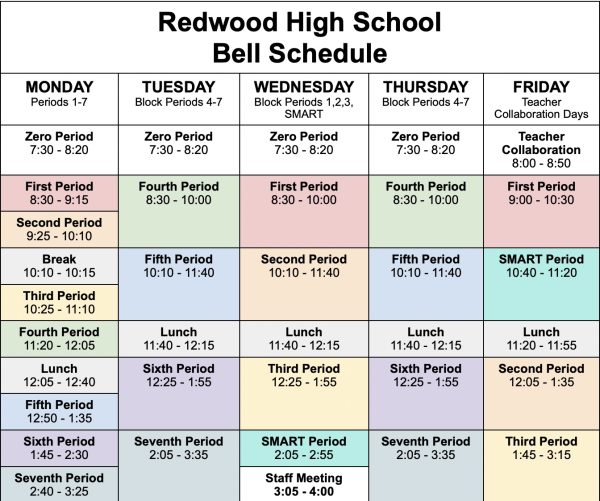Fighting through Marin’s Omicron wave
February 13, 2022
Defining Omicron
First detected in South Africa on Nov. 24, 2021, the Omicron variant of COVID-19 has since spread across the globe, taking over schools, hospitals and other facilities. The variant, though less severe in symptoms than previous ones, poses serious threats to public health. Its contagious nature has caused the number of cases in recent months to skyrocket. Jumping from 40 to 646 new cases from December to January, Omicron has significantly impacted Marin County despite the 94.7 percent vaccination rate for the eligible population.
According to a January 2022 Bark survey, 91 percent of students have either had COVID-19 or know somebody at Redwood who has had COVID-19 in the last two months. The high figure is likely due to the high transmissibility of the variant.
Infectious disease specialist at a Bay Area hospital Dr. Hui Zhao noted the main difference between the Omicron variant and previous variants is its contagion.
“Just the sheer number of people infected is unprecedented,” Zhao said.
She acknowledged that another unique trait of the Omicron variant is its lower incubation period, meaning those infected develop symptoms sooner after exposure. While the Delta variant had an incubation period of approximately five days, Omicron symptoms are commonly visible three days after exposure.
Emergency physician at Marin Health Medical Center and Redwood parent Dr. Tami Gash-Kim also identified a difference in symptoms of the Omicron variant.
“There’s overlap [between Omicron and other variants], but it is still subtly different,” Gash-Kim said. “There are similar upper respiratory tract infection symptoms, but not so much the loss of smell and loss of taste [associated with the Delta variant]. It’s predominantly the sore throat kind of symptoms.”
Despite its mild symptoms, prevention against the variant is still important. The COVID-19 vaccine greatly affects one’s chances of contracting the virus. According to an article published by Marin Human Health and Services at the end of January, for every 100,000 residents in Marin on a seven-day average, the unvaccinated case rate was around 999, while the vaccinated case rate on the same day was around 85. This contrast in numbers indicates the vaccine is preventing the spread among the vaccinated population of Marin.
“We see significant protection in patients who have had [both] the vaccine and the booster against infections, severity of the disease, hospitalizations and deaths,” Gash-Kim said.
Hospitals
The high infectivity rate has led to an employee shortage across the nation for all professions. However, the issue is most prevalent in hospitals, where healthcare workers are often exposed to the variant.
“I think the toughest part right now is [that] not only is the hospital busy with the number of patients infected with Omicron but there is also the lack of healthcare workers,” Zhao said. “Because the healthcare workers themselves are getting sick, there is a lack of staff to take care of these people.”
The rising count of cases also leads to the unavailability of beds for patients without COVID-19.
“If [a patient with COVID-19] is taking up a bed, it means one less bed for someone who needs a hospital bed for another condition. If the hospital’s full, people who need outpatient surgery and a bed afterward have to delay their surgery,” Zhao said.
Hospital resources are further depleted when those who cannot find COVID-19 tests crowd emergency rooms — one of the only reliable sources for tests.
“The number of people needing [a COVID-19] test is straining our healthcare system. People sometimes can’t get a test for a week and then they go to the emergency room thinking they can get a test sooner, but that crowds the emergency room and delays care elsewhere,” Zhao said.
Redwood’s Approach
After returning from winter break, Redwood decided to take a preventive approach to deal with the Omicron variant. All students were encouraged to take an antigen test, otherwise known as a rapid test, multiple days before coming back to school. Those who tested reported their result to the school upon returning.
Vice Principal and public health liaison Saum Zargar was surprised with the results of the testing.
“[The county] hypothesized that of all the people who reported their results, one to two percent would be positive. What we realized is that it was double that rate. The percent that tested positive before coming to school was closer to four to five percent,” Zargar said.
Zargar oversaw the daily testing of students and faculty that occurred throughout the month of January. Teachers were allowed to test weekly at school; should they test positive, the administration had conferred with faculty regarding their options.
“To support our teachers, they can still teach their class [over Zoom] and not necessarily use their sick days … if they have no symptoms or if they feel okay enough to do so,” Zargar said. Update: This option for Zoom is continuing for teachers in the foreseeable future.
Student prevention options, however, differ from those of faculty. During the month of January, students were not given the option to test weekly through the school as teachers were. Additionally, the school has moved away from informing students of classroom exposures. Instead, students are only informed via email if they sit within close proximity to the positive student. If a student tests positive, they are required to reach out to their teachers to find a new way to complete the assignments, as Zoom classes were only required in the month of January. They must do this until they test negative or after 10 days of quarantine.

Advanced Placement Language and Composition teacher Dr. Fiona Allan has made further efforts to ensure safety in her classes. In addition to keeping her classroom’s windows open at all times and washing her hands frequently, Allan sent a video from the Center for Disease Control and Prevention (CDC) to her students and their parents about how to properly wear a mask using the knot and tuck method.
“A lot of students haven’t been taught how to wear their masks. They have their masks down beneath their noses, so I’m reminding them that they need to wear the masks properly,” Allan said.
After sharing the video, Allan noticed students in her classroom increasingly wearing their masks correctly. Allan also keeps extra masks in her desk to aid students who come in wearing cloth masks, which have been proven less effective than surgical or N95 masks.
“It’s a tricky situation with our campus. I think about Tamalpais and Archie Williams, they are much more open campuses with more outdoor [spaces]. We are much more indoors, so it’s a tricky balance with students going in the hallways,” Allan said.
Despite the recent spike in the number of cases, the administration and district have not detailed the criteria for fully online learning.
“We want kids in school. We want teachers in school and when [teachers] cannot physically be in school then we are giving them the option to Zoom in while they are quarantining and keeping safe,” Zargar said. “Our intention is to keep schools open. We believe the safest place for kids to be is in school.”
Effect on Redwood
Throughout the first semester of the 2021-2022 school year, Zoom school was not an option for students who contracted COVID-19. However, when the Omicron variant started an uptick in cases over winter break, the Tamalpais Union School District (TUHSD) started providing Zoom links for quarantining students.
Junior Mia Solomon tested positive for COVID-19 at the beginning of January after being unknowingly exposed at swim practice. Solomon quarantined for 10 days, testing positive on both the fifth and seventh days.
Solomon presented similarly to the descriptions of Omicron that Gash-Kim and Zhao observed. When she first tested positive, Solomon had no symptoms and was only taking a precautionary test to ensure a negative result. A few days into her quarantine, she developed a slight cough, but nothing more than the average cold. Solomon found that in addition to staying home, Zoom school proved to be a challenge.
“It was very lonely. In a lot of my classes, I was the only person on Zoom,” Solomon said. “It was really different from Zoom [in 2021] because the teachers didn’t really pay attention to what was happening on Zoom. They just focused on the [physical] class. I could only sort of hear what they were saying from far away, and they just let [the Zoom] run.”
In addition to the students that felt a loss of connection, teaching proved more difficult with some students online.
“There is magic that happens in the classroom. The balance of teaching [both in-person and on Zoom] is a fine one to strike. It’s like dividing yourself in two,” Allan said.
Allan also noted that the disconnect between those at home made it difficult for them to participate in class and for her to teach. Switching back and forth between the Zoom and the in-person class was confusing; the balance of last year’s Zoom took time to master, but this year’s constantly changing conditions made adapting even harder.
“Once we get it, things change again. It’s just always a stance that’s constantly changing, and the goalposts are always moving. Sometimes I feel like we are a bit in triage mode,” Allan said.
Current Update
The number of new cases in Marin are already dropping. With a decrease of 110 cases in the last 14-day period, the wave of Omicron in Marin seems to be passing.
Additionally, Redwood has ceased to require teachers to provide Zoom links for students who are ill or quarantining, as this mandate was only for the month of January, due to the decrease in COVID-19 positive students at Redwood. Additionally, teachers and students are both unable to take a COVID-19 test at school as of Feb. 1.
“There’s always changing policies, either within the organization, from the CDC, from the California Department of Public Health or even local calls. So just trying to catch up with that can be challenging,” Zhao said.
Even in the past few weeks, a new subvariant of Omicron, BA.2, has been detected. Scientists have found that the symptoms and effects are similar to that of BA.1, the current variant, but it is around 1.5 times more transmissible. According to Zhao, as COVID-19 procedures and variants are ever-changing, it is vital to remain updated on CDC guidelines.
“I think the main thing right now is definitely to get vaccinated. And number two is, just like throughout the entire pandemic, masking, hand hygiene and social distancing,” Zhao said.
























